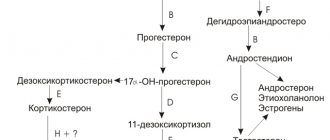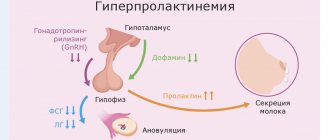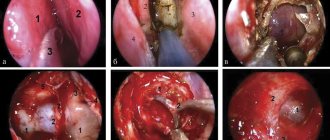Hypertrichosis is often confused with hirsutism. The difference is that with hirsutism, a woman’s hair grows according to the male pattern and the reason for this is the excessive formation of androgens. And with hypertrichosis there is too much vellus hair, which is distributed throughout the body and becomes black and hard.
The most pronounced hair in hypertrichosis appears on the body in the following places: the chin, above the upper lip in the area of the nasolabial folds, in the chest area, on the lower back, pubic hair begins to grow as in men.
Sometimes hypertrichosis develops in a girl during adolescence; less often, this disease can be found in a child.
Assessing the degree of female hairiness
Not all hair on the body is superfluous and, perhaps, you consider that vegetation that is physiologically acceptable and grows within normal limits to be superfluous. The Ferriman-Gallwey scale is used for assessment. The scale has 4 rating options (you can find comparative photos on the Internet): 0 - hair is completely absent, 4 - hair growth is well expressed. This scale evaluates vegetation in the following locations: above the upper lip, in the abdomen, back, chest, pubic area, arms and inner thighs. If you evaluate the degree of hair growth in all these places and score 8 points, then you can assume the presence of pathology.
Hirsutism in girls and adolescents
Hirsutism refers to excessive hair growth in females according to the male pattern, i.e. the appearance of terminal hair on the upper lip, chin, sternum, upper back, midline of the abdomen, sacrum, buttocks, inner thighs. Hirsutism is not only a cosmetic problem, but also often a symptom of serious diseases.
Physiology of hair growth
There are about 50 million hair follicles on the human body, and only a small part (100–150 thousand) are located on the scalp. Only the palms, feet, and lips are free from hair. The main part of hair follicles is formed from ecto- and mesoderm in the prenatal period. These elements are in close contact throughout the life of the hair follicle.
The first hair appears in a person at the end of the 3rd month of intrauterine life, and at the 7th month - vellus hair (lanugo), which covers all parts of the body with the exception of the palms, soles, and breast nipples. Lanugo is soft, delicate, fine hair without medulla, about 2 mm in length, moderately pigmented. As the fetus develops, their number decreases, and by the fourth month of the child’s life they completely fall out.
Before birth, they are replaced with baby hair. Terminal hair forms at the beginning of puberty - this is thick hair on the pubis and armpits, and in men on the face, abdomen, and limbs.
Hair growth has a lot to do with gender. Men have more hair and it grows faster. This is caused by the presence of a high concentration of androgens in their body. With an increase in this hormone, more body hair appears.
There are three phases of hair growth. The active phase is anagen, followed by the involution phase (catagen), in which the hair stops growing and the hair follicle decreases in size, and finally the telogen phase, in which the old hair is replaced by a new one. The duration of catagen and telogen is on average from 2–3 weeks to 3–4 months, respectively. The ratio of anagen to telogen hairs is used to determine hair growth activity, with a higher ratio indicating active growth. The frequency and location of hair follicles in the skin is an individual feature of the body [1].
Each hair consists of a shaft and a root. The entire hair root is enclosed in a hair follicle. Cells of the papillary dermis of androgen-dependent areas have a large number of androgen receptors compared to other areas of the skin.
All androgens are C19 steroids, derivatives of androstane, and have different biological activities. The main sources of androgen production in the female body are the theca cells of the ovaries, the reticular layer of the adrenal cortex, peripheral conversion from steroid hormone precursors (androstenedione, dehydroepiandrosterone (DHEA)) in the liver, muscles, skin and adipose tissue.
In circulation, along with testosterone, 5-androstenedione, 4-androstenedione, androsterone and DHEA, which have little biological activity, are determined. They are precursors or products of testosterone metabolism.
In target cells (skin, muscle, adipose tissue), testosterone is exposed to the tissue enzyme 5α-reductase, turning into 5α-dihydrotestosterone (DHT), which has maximum androgenic activity. Free fractions of testosterone have greater biological activity. Penetrating into the target cell, they bind to the nuclear receptor. Under physiological conditions, androgens act as anabolic factors [2].
Sex hormones, mainly androgens, are transported by a specific protein - sexsteroid binding globulin (SSBG). 1–3% of androgens circulate in a free state, which have a biological effect on cells. Its level decreases under the influence of androgens, glucocorticoids, growth hormone, thyroid hormones, and excess body weight.
Inactivation of sex steroids occurs mainly in the liver due to the processes of conjugation with glucuronic acid and sulfonation. The concentration of steroids in the blood is determined by the interaction of biosynthesis and degradation activities.
Sexual hair growth depends on androgen levels. Before puberty, the hair is delicate (short length, straight, light), and the sebaceous glands of the skin are little active. In response to increased androgen levels during puberty in hormone-sensitive areas, children's hair transforms into coarse terminal hair (darker, curlier). High levels of androgens are necessary for hair growth in the axillary and pubic areas. In other areas of the skin, such as the forehead, for example, the same level of androgens increases the activity of the sebaceous glands, but does not cause differentiation of vellus hair. The reasons for this are currently not entirely clear [3].
In the periphery, 5α-reductase activity is increased by local growth factors and circulating androgens. In the body, dihydrotestosterone stimulates: the production of sebum, the differentiation of the hair follicle from vellus hair to axial hair, and prolongs the anagen phase. As a result, the hair thickens.
Ethnic origin significantly influences the growth of terminal body hair. Differences between hair levels in humans are thought to be related to the sensitivity of the hair follicle to the enzyme 5α-reductase, as well as androgen receptor polymorphism. Northern peoples have the least amount of terminal hair, while Southern Europe and dark-skinned Mediterranean women have a lot of it.
Pathogenesis of hirsutism
Hirsutism is the result of an imbalance between hormone levels and the sensitivity of hair follicles to androgens. It is an important symptom of androgen-dependent dermatopathy. The severity of this symptom depends on many factors: the ethnicity of the woman, the duration and depth of the pathological process, the spectrum and level of secreted androgens, which give a different virilizing effect.
In the population, the majority of girls whose blood androgen levels are 2 times higher than the average norm have a moderate degree of hirsutism. However, the severity of hirsutism does not always correlate with androgen levels, as androgen sensitivity varies significantly between individuals. Some women with hyperandrogenism syndrome do not have hirsutism, but have other skin manifestations such as seborrhea, acne vulgaris, and alopecia. But the appearance of terminal hair in the lower abdomen, lower back, near the nipples, on the arms and legs is normal.
The level of testosterone in the middle phase of the menstrual cycle varies greatly during the day - the maximum level is in the morning and lower before the onset of menstrual flow. The biologically active part of testosterone - the free fraction - can increase, while the level of total testosterone will be within normal limits. This reflects the relatively low level of sexsteroid-binding globulin, which determines the proportion of free and albumin-bound plasma testosterone [4].
So, the pathogenetic mechanisms of the development of hirsutism are extremely diverse and insufficiently studied.
Causes of hirsutism
Androgen-dependent forms of hirsutism are the most common (75–85%). In the female body, hirsutism, acne, seborrhea, hair loss, deepening of the voice, clitoral hypertrophy can become the first and sometimes the only early diagnostic signs of hyperandrogenemia syndrome.
Polycystic ovary syndrome
Polycystic ovary syndrome (PCOS), ovarian sclerocystosis, Stein-Leventhal syndrome. A disease based on the process of cystic ovarian degeneration. It is characterized by oligo- or amenorrhea, excess body weight, hirsutism, acne vulgaris, alopecia, enlarged, polycystic ovaries and anovulatory cycles. PCOS, including incomplete forms, is detected in 70–80% of women. The pathogenesis of the syndrome has not been fully elucidated. Occurs in 1.4–2.5% of girls examined for amenorrhea. Current evidence suggests that various factors are involved in the formation of polycystic ovary syndrome. This is a disorder of the secretion of sex steroids in the ovaries; disorders in the hypothalamus-pituitary-ovarian system, androgen synthesis in the adrenal glands, ovaries; receptor damage in effector cells for these hormones involved in the implementation of biological effects.
A certain contribution to the development of polycystic ovary syndrome is made by insulin resistance, which is associated with impaired action of insulin at both the receptor and post-receptor levels, as well as hyperprolactinemia [5].
The disease is detected during puberty due to menstrual irregularities (primary or secondary amenorrhea). At the same time, hirsutism of varying severity develops. Hair growth can be above the upper lip, around the nipples of the mammary glands, along the white line of the abdomen, on the thighs. Most patients have varying degrees of obesity. The external genitalia are formed according to the female type. Only in some patients does increased androgens cause enlargement of the clitoris.
The diagnosis is confirmed by an almost 2-fold increase in luteinizing hormone (LH), with normal or even reduced levels of follicle-stimulating hormone (FSH). The LH/FSH ratio is always increased. In half of the patients, the content of testosterone and dehydroepiandrosterone sulfate (DHEA-S) was increased, in a third - prolactin. Carrying out a test with gonadoliberin (LH-RH) causes a hyperergic reaction with a sharp increase in LH and lack of response from FSH. A dynamic study of the hormones LH, FSH, estrogen, progesterone reveals monotonous indicators, which confirms the absence of an increase in rectal temperature. This indicates anovulatory cycles [6].
Ultrasound examination (ultrasound) shows the ovaries are enlarged in size, the capsule is dense, the stroma is well defined, and numerous cysts are detected.
Aromatase deficiency
Aromatase is an enzyme necessary for the conversion of testosterone to estradiol (E2) and androstenedione to estrone (E1).
Aromatase deficiency in girls leads to the absence of estrogen-dependent signs of puberty and the appearance of androgenization symptoms. In newborn girls (XX), symptoms of virilization of the external genitalia (hypertrophy of the clitoris, fusion of the labial suture) are observed.
During puberty, girls with aromatase deficiency have no enlargement of the mammary glands and no menstrual function. Symptoms of virilization intensify. Polycystic changes are observed in the ovaries.
Laboratory tests reveal high levels of testosterone, androstenedione, dehydroepiandrosterone and its sulfate. Estrogen levels are significantly reduced. Gonadotropic hormones are increased. Genetic studies reveal a mutation in the aromatase gene CYP19. Estrogen therapy has a positive effect on breast development and the onset of menarche [7].
Hyperprolactinemia
The appearance or intensification of hirsutism, especially in patients with oligoamenorrhea or amenorrhea, may be due to hyperprolactinemia (HP). An increase in prolactin secretion directly stimulates steroidogenesis in the adrenal glands, therefore, in patients with pituitary adenoma, the content of DHEA and DHEA-S significantly increases with moderate testosteronemia [8].
The secretion of prolactin is regulated by the hypothalamus, which produces prolactoliberin and prolactostatin (dopamine). The pathogenesis of hypogonadism with hyperprolactinemia is primarily due to the suppression of impulse secretion of LH-RH by excess prolactin and a negative effect on the processes of steroidogenesis in the gonads. Violation of the hypothalamic regulation of prolactin secretion - a decrease in dopaminergic influence or an increase in the production of prolactoliberin - leads to hyperplasia of pituitary lactophores with the possible development of micro- and macroadenomas.
The earliest symptom of HP is menstrual dysfunction, which is a reason for patients to consult a doctor. The examination allows, in some cases, to identify a pituitary adenoma at the microadenomas stage. Prolactinomas, according to the children's clinic of the Research Center of the Russian Academy of Medical Sciences, account for 22% of diagnosed pituitary adenomas. More often they were detected in girls during puberty and manifested themselves in the form of primary amenorrhea syndrome.
Hyperprolactinemia occurs in tumor diseases of the hypothalamus and pituitary gland, damage to the pituitary stalk, “empty sella” syndrome, as well as injuries and inflammatory processes of the base of the skull [9].
According to A. Tuzcu et al. Elevated prolactin levels are associated with more severe manifestations of hirsutism and hyperandrogenic ovarian dysfunction, with more pronounced insulin resistance. It has not yet been clarified whether HP is the cause or consequence of hyperandrogenism in some patients [10].
Congenital adrenal dysfunction (CAD)
This is a large group of diseases that have one or another genetic enzymatic defect at various stages of the biosynthesis of steroid hormones, leading to insufficient secretion of cortisol. Cortisol deficiency stimulates the production of pituitary adrenocorticotropic hormone (ACTH) in the adenohypophysis, which causes adrenal hyperplasia. The clinical picture depends on the level of enzymatic disorder. In these diseases, androgen precursors accumulate.
The severity of the influence of androgens in 21-hydroxylase deficiency is associated with individual characteristics of the metabolism of androgen precursors and differences in the activity of peripheral androgen receptors.
If the diagnosis of CAH is not made in a timely manner and appropriate treatment is not started, then due to the anabolic effect of androgens in the first years, girls grow rapidly, their skeletal muscles actively develop, a rough voice appears, and hirsutism (male-type hair growth on the face, chest, abdomen, and limbs) , i.e. signs of masculinization. In patients, the size of the clitoris increases and its tension is noted [11].
Girls in pre- and puberty do not have secondary sexual characteristics and menstruation. Increased secretion of androgens by the adrenal glands, according to the feedback principle, blocks the release of gonadotropins in the adenohypophysis. For this reason, in patients the ovaries are reduced in size with multiple cysts, the uterus is underdeveloped. Skeletal differentiation is significantly accelerated (“bone” age is ahead of passport age). By the age of 10–12 years, the epiphyseal zones of bone growth occur, which determines the final short stature of patients. Their body proportions are disturbed: wide shoulder girdle, narrow pelvis, well-developed muscles. Girls do not develop mammary glands.
With the expansion of diagnostic capabilities, more and more variants of non-classical pubertal variants of CDCN are being identified. The first clinical symptom may be accelerated isolated pubarche. In the juvenile period, with moderate hyperandrogenemia, hirsutism develops with accompanying symptoms. Hyperandrogenic ovarian dysfunction is formed.
The non-classical variant of 21-hydroxylase deficiency with manifestations of hirsutism and hypertrichosis is very common in some ethnic groups of Yugoslavia, Spain, and Ashkenazi Jews.
Premature adrenarche
Premature adrenarche (PA) is the appearance of isolated pubic and/or armpit hair in girls under 8 years of age (usually at the age of 6–8 years). PA may be a normal variant, given that the maturation of the zona reticularis of the adrenal cortex begins at 6 years of age. While the secretion of gonadoliberins, responsible for the onset of puberty, starts later. The cause of pubertal hair growth is an increase in the production of DHEA and DHEA-S by the adrenal glands, as well as 4-androstenedione, testosterone precursors that stimulate pubic and axillary hair growth. In girls, PA may be associated with excessive peripheral conversion of testosterone to dihydrotestosterone (increased 5a-reductase activity). In the absence of other signs of androgenization of the body - accelerated growth, skeletal maturation, pre-pubertal size of the uterus and ovaries, normal testosterone levels and moderately increased DHEA-S, the prognosis is favorable and sexual development does not deviate from the norm [12].
However, in some children, PA can be triggered by excess production of ACTH (hydrocephalus, meningitis, etc.). There is increasing evidence linking PA with non-classical forms of CAH and, in particular, deficiency in the activity of the enzyme 21-hydroxylase and, less commonly, 3β-hydroxysteroid dehydrogenase. The mechanism of PA is associated with the early maturation of the zona reticularis of the adrenal cortex, evidence of this can be the increased level of DHEA-S. Secretion of adrenal androgens has been shown to be stimulated by ACTH and suppressed by dexamethasone.
In the presence of a virilizing disease, clinical signs of androgenization appear: clitoral hypertrophy, high posterior perineal commissure, hirsutism, development of the muscular system; activation of sebaceous and sweat glands. These children experience accelerated growth and bone age. It should be noted that adrenarche precedes the increase in gonadotropins by about 2 years and is not associated with either an increase in the sensitivity of gonadotrophs to LH-RH or an increase in the amplitude and frequency of nocturnal LH surges.
Girls with premature adrenarche should be at risk for developing polycystic ovary syndrome. This group of patients requires corrective therapy with glucocorticoids [13].
Hyperandrogenism in patients with thyroid dysfunction (hypothyroidism) is based on a significant decrease in the production of globulins that bind sex steroids. Due to a decrease in the level of CVD, the rate of conversion of androstenedione to testosterone increases [14].
Obesity
About half of those with hirsutism are overweight. With the progression of obesity and with increasing age of children, complications or accompanying diseases appear.
Currently, abdominal fat is considered as an active hormone-producing organ that secretes a large number of factors (adipokines) with various effects. They are involved in the regulation of energy balance, cardiovascular system, endocrine system, etc.
Obesity is accompanied by the development of serious complications, including insulin resistance, hyperglycemia, dyslipidemia, arterial hypertension, and hyperandrogenism. Excessive amount of adipose tissue can affect the timing of the child’s puberty and hormonal balance.
Hyperinsulinemia associated with obesity contributes to the development of hyperandrogenemia [5]. Insulin and insulin-like growth factor 1 have the ability to increase the androgen response of ovarian theca cells to LH stimulation. It is believed that insulin increases the sensitivity of the adrenal glands to the action of ACTH. Hyperinsulinemia that occurs in obesity inhibits the hepatic production of CVD, which leads to an increase in free plasma testosterone.
Girls with obesity and PA, adolescents with PCOS have higher values of insulin resistance, a greater decrease in CVD levels and an increase in androgen concentrations compared to their peers with exogenous constitutional obesity. Girls with PA are at risk for developing polycystic ovary syndrome.
M. Mustaqeem et al. studied ethnic differences in clinical and biochemical parameters of South Asian and European women with PCOS (47 Asian and 40 European women) and controls (11 Asian and 22 European women). They reported a significantly higher prevalence of hirsutism, acne, acanthosis nigricans, and secondary infertility in Asian women with PCOS. Insulin resistance is considered to be the central link in the pathogenesis of PCOS, but the specific causes are not yet clear and are being actively studied [15].
Androgen-secreting tumors
Androgen-secreting tumors of the adrenal glands (androsteromas) are usually classified as adrenocarcinomas. They are rare in children. In early adolescence, the frequency of adrenocarcinomas increases in children with Wiedemann-Beckwith syndrome (visceromegaly, macroglossia, hemihypertrophy) and Li-Fraumeni syndrome (multiple malignant neoplasms).
In patients with adrenocarcinomas, abnormal expression of tumor markers and decreased expression of factors that suppress tumor growth, the genes of which are localized on the long arm of chromosome 11, were revealed. Abnormalities of this chromosome are detected in most patients with adrenocarcinoma.
Girls show signs of virilization: apocrine glands (sweat, sebaceous, hair follicles) are activated, body weight increases due to muscle tissue, the clitoris hypertrophies, and growth accelerates [2].
Steroid-secreting gonadal tumors
Steroid-secreting gonadal tumors are uncommon in childhood. In older girls, arrhenoblastomas (malignant tumors) are found, located in the cortex or in the area of the ovarian hilum. Undifferentiated tumors have a more pronounced virilizing effect, while differentiated ones have both a weakly expressed masculinizing and feminizing effect [16].
Excessive growth of terminal hair with a male distribution is often found in girls with hypothalamic syndrome during puberty, manifested by menstrual irregularities (oligomenorrhea, amenorrhea, uterine bleeding).
In some patients with true precocious sexual development (PPD), the cause of the disease cannot be identified. In such cases, when organic diseases of the central nervous system are excluded, a diagnosis of the idiopathic form of PPR is made. However, the improvement of research methods (computer and magnetic resonance imaging) of the brain makes it possible to more often identify the cause of the cerebral form of hyperandrogenemia (hamartoma, glioma, hCG-secreting tumors, etc.) in girls.
Cornelia de Lange syndrome
A rare genetic syndrome with an overall prevalence of 1.6–2.2:100,000 people. It is dominantly inherited, most cases are associated with de novo mutations. The syndrome is genetically heterogeneous, half of the cases are associated with mutations in the regulator gene NIPBL and HDAC8, about 5% of cases are associated with mutations in the SMC1A gene (SMC3, RAD21), which encodes a protein in the cohesin complex. The clinical picture is very variable, typical are facial dysmorphia, microcephaly, hearing loss, vesicoureteral reflux, intrauterine growth retardation and slower postnatal growth of the child, malformations of the limbs and genital organs, hirsutism, congenital heart defects and gastrointestinal tract defects. Distinctive facial features: low hair growth, thick fused eyebrows, thick and long eyelashes. Hirsutism is observed in 78% of patients. More than half of newborns experience increased hairiness on the back, and sometimes on the entire body.
The syndrome is often accompanied by epilepsy, behavioral problems in the form of attention deficit disorder, aggression, including auto-aggression. Specific treatment and prevention have not currently been developed.
Rubinstein Taybi syndrome
Rare genetic disease. Average incidence is 1 in 10,000–300,000 births. The disease is characterized by varying degrees of intellectual impairment, specific facial features and hand structure (abnormally wide and often curved thumbs), and dysphagia. Hirsutism occurs in half of the cases. The disease is associated with a de novo gene mutation and can be inherited in an autosomal dominant manner. The most common variant is a defect in a gene located on the short arm of chromosome 16 (16p13.3). The syndrome is based on a defect in the CREBBP and EP300 genes; patients with the EP300 mutation have less severe skeletal abnormalities. On the contrary, patients with a deletion of chromosome 16, containing the EP300 and CREBBP genes, have severe multiple malformations.
Diagnosis is often made phenotypically. Features of the facial structure: anti-Mongoloid eye shape, long eyelashes, arched eyebrows, high palate, low-hanging nasal septum (columella). There are many complications associated with this syndrome, for example, heart and kidney defects, obesity, otitis media, and a high risk of neoplastic processes.
Donahue syndrome
An extremely rare genetic disease characterized by impaired insulin tolerance, growth retardation, and endocrinopathies. It may be caused by a disorder in the gene located on the short arm of chromosome 19 (19p13.2), which is responsible for the regulation of insulin receptors. Children with Donahue syndrome experience delayed postnatal growth and impaired bone maturation. Low muscle mass. Children have a peculiar facial structure: low-set, poorly developed ears, thick lips and a large mouth, a flat bridge of the nose, widely spaced eyes, and microcephaly.
In most cases, there are structural features of the skin: thickening, darkening (acanthosis nigricans), hirsutism, acanthosis nigricans. Hyperandrogenism of ovarian origin.
Girls have enlarged mammary glands and clitoromegaly. Due to persistent hyperinsulinism, severe fasting hypoglycemia. The prognosis is unfavorable.
HAIR-AN syndrome
The subphenotype of polycystic ovary syndrome, manifested by hyperandrogenism, insulin resistance, obesity and acanthosis nigricans, has been known for more than 30 years. PCOS is one of the most common causes of menstrual irregularities in girls. Statistics on visits to outpatient clinics among adolescents over a 2-year period showed that out of 1002 girls (age 10–21 years), 5% (50) were diagnosed with HAIR-AN syndrome. The average age of the patients was 15.5 years, the average weight at the time of diagnosis was 94.5 kg (BMI 33.3 kg/m2). Treatment is based on weight loss and the use of metformin. 80% of patients had a response to treatment, 95% established a regular menstrual cycle, hirsutism and acne decreased [15].
About 5% of girls with hyperandrogenism and insulin resistance have acanthosis nigricans. Patients with HAIR-AN syndrome may have other signs of virilization with normal adrenal function, amenorrhea. Patients usually have normal levels of LH and FSH, although their ratio may be disrupted.
Symptoms of hirsutism can be provoked by long-term use of hormonal drugs: anabolic steroids, androgens, glucocorticoids, estrogen-containing drugs (oral contraceptives), etc. Antidepressants and some cytostatics provoke active hair growth.
Constitutional hirsutism
Excessive hair growth is genetic. Hereditary predisposition leads to the development of the so-called constitutional form of hirsutism. In this case, hirsutism is often regarded not as a pathology, but as one of the normal variants. It is found in women of the Mediterranean and Middle East. The cause of hereditary hirsutism is considered to be increased sensitivity of hair follicles to dihydrotestosterone. Even a small amount of androgens, which is normal for women, leads to faster and more abundant hair growth. Excessive hair growth begins to appear in childhood and reaches a peak during adolescence. There are no other symptoms of androgenization. In case of excessive hair growth, it is recommended to consult a dermatologist or cosmetologist and undergo regular hair removal.
Idiopathic hirsutism
The diagnosis of “idiopathic hirsutism” is made in cases where no cause for excess hair growth can be found. According to clinical symptoms and development mechanism, it is very close to the hereditary form of excess hair growth. Patients with idiopathic hirsutism do not have other complaints associated with androgenemia. Unlike hereditary hirsutism, the disease may not appear in adolescents, but at a later age. In these cases, the mechanisms that influence the sensitivity of hair follicles to androgens are not clear.
Differential diagnosis
Hirsutism should be distinguished from hypertrichosis, a general excess hair growth that is a consequence of a person’s constitutional characteristics. With hypertrichosis, excess hair is observed in areas of the body that are not typical for women (on the limbs, chest). As a rule, these areas of the skin are covered with vellus bleached or dark-colored hair. With hypertrichosis, there is no increase in hair growth only in androgen-dependent areas and is not directly related to hyperandrogenemia, although this may aggravate the manifestation of hirsutism. Hypertrichosis can be a consequence of the use of medications such as steroids, immunosuppressants, etc.
Survey
The heterogeneity of hirsutism requires a thorough search for its cause. You should pay attention to the patient’s age, relationship with medications, family history of hirsutism, and ethnicity. The severity of hirsutism is assessed using the Ferriman-Gallway scale, which allows you to assess the prevalence of coarse hair in nine androgen-dependent areas - the upper lip, chin, shoulders, chest, upper and lower abdomen, back, lower back, hips. The assessment is made on a five-point scale, and the overall severity of hirsutism can vary from 0 to 36 points. If the indicator is 8 points or higher, then we can talk about the presence of hirsutism.
During the examination, it is necessary to measure height, weight, subcutaneous fat distribution, body mass index (BMI), waist and hip circumference, and blood pressure. Determine the stage of sexual development. Note skin changes.
Laboratory tests are carried out to confirm the diagnosis of hyperandrogenemia in the appropriate clinic and to identify the source of excess androgens: adrenal glands, ovaries, central nervous system.
- Biochemical blood test: total cholesterol, LDL, HDL, triglycerides, enzymes (ALT, AST).
- Fasting glucose, glucose tolerance test.
- Hormonal profile: insulin, C-peptide, LH, FSH, cortisol, testosterone, DHEA, DHEA-S, prolactin, 17-hydroxyprogesterone, according to TSH, T4, SSSH.
- Bone age.
- Bioimpedance measurements are used to assess fat mass.
- Ultrasound of the liver, pancreas, kidneys, adrenal glands, ovaries.
- Molecular genetic research.
- To clarify the cause of hirsutism, ultrasound or computed tomography of the pelvic organs and adrenal glands, and magnetic resonance imaging of the brain are recommended.
- To exclude tumors in the ovaries, diagnostic laparoscopy is performed.
Treatment
Treatment of hirsutism, if caused by hyperandrogenemia, is difficult. The main goal of treatment is to normalize the secretion of steroid hormones that cause excess hair growth and other symptoms of androgenization. This pathology may be caused by a disorder in the gonadostatic system at various levels, requiring an individual approach to the choice of treatment method. The use of only cosmetic measures, especially in severe forms of the disease, leads to a short-term clinical effect and extremely rarely to a cure. Diagnosis and treatment of patients with hirsutism is usually carried out by an endocrinologist, gynecologist, or dermatologist.
The main problem for teenage girls with hirsutism is psychological complexes due to a cosmetic problem. Mental changes are characterized by symptoms of depression. Teenagers are depressed and almost always see the reason for their failures in defects in appearance. They need psychological support. Carrying out psychocorrective measures under the supervision of a doctor and psychologist will allow girls with hirsutism to take responsibility for control and become accomplices in the treatment of their disease.
Correctly carried out psychocorrection helps to reduce the clinical manifestations of the disease, increase the social activation of patients, their adaptation in the family and society, and also increases the effectiveness of treatment measures.
Literature
- Skripkin Yu. K., Kubanova A. A., Akimov V. G. Skin and venereal diseases: textbook. 2011. 544 p.
- Dedov I. I., Semicheva T. V., Peterkova V. A. Sexual development of children: norm and pathology. M., 2002. 232 p.
- Ragimova Z. E., Kail-Goryachkina M. V. Interdisciplinary aspects of androgen-dependent dermopathy (literature review) // Consilium Medicum. Dermatology. 2016, 3: 56–62.
- Guide to pediatric endocrinology / Ed. Charles G. D. Brooke, Rosa Lind S. Brown: trans. from English edited by V. A. Peterkova. M.: GEOTAR-Media, 2009. 352 p.
- Gurkin Yu. A. Children's and adolescent gynecology. M.: MIA, 2009. pp. 148–180.
- Bogatyreva E. M., Novik G. A., Kutusheva G. F. Phenotypes and endotypes of hyperandrogenism syndrome in adolescent girls // Treating Physician. 2016, no. 2, p. 70.
- Wilson JD, Aiman J., MacDonald PC The Pathogenesis of Gynecomastia // Advanc. in intern. Med. 1980, 25: 1–32.
- Moskovkina A.V., Puzikova O.Z., Linde V.A., Rybinskaya N.P. Hyperprolactinemia in adolescent girls with hyperandrogenism syndrome // Children's Hospital. 2013, no. 2, p. 35–39.
- Kokolina V.F. Gynecological endocrinology of children and adolescents. M.: Medical Information Agency, 2001. 287 p.
- Zhurtova I. B. Hyperprolactinemia syndrome in children and adolescents. Optimization of diagnostic and treatment methods. Author's abstract. diss. Doctor of Medical Sciences, M., 2012.
- Tuzcu A., Bahceci M. et al. Is hyperprolactinemia associated with insulin resistance in non-obese patients with polycystic ovary syndrome // J Endocrinol Invest. 2003; 26:655–659.
- Dedov I. I., Peterkova V. A. Guide to pediatric endocrinology. M.: Universum Publishing, 2006. 600 p.
- Endocrinology. National leadership. Brief edition / Ed. I. I. Dedova, G. A. Melnichenko. M: GEOTAR-Media, 2013. 752 p.
- Dedov I. I., Peterkova V. A. Federal clinical recommendations (protocols) for the management of children with endocrine diseases. M.: Praktika, 2014. 442 p.
- Onal ED, Saglam F., Sacikara M., Ersoy R., Cakir B. Thyroid autoimmunity in patients with hyperprolactinemia: an observational study // Arq Bras Endocrinol Metabol. 2014, Feb
- Mustaqeem M., Sadullah S., Waqar W., Farooq MZ, Khan A., Fraz TR Obesity with irregular menstrual cycle in young girls // Mymensingh Med J. 2015, Jan; 24 (1): 161–167.
- Peterkova V. A., Semicheva T. V., Gorelyshev S. K., Lozovaya Yu. V. Premature sexual development. Clinic, diagnosis, treatment. A manual for doctors. M., 2013. 40 p.
V. V. Smirnov1, Doctor of Medical Sciences, Professor A. A. Nakula
Federal State Budgetary Educational Institution of Russian National Research University named after. N. I. Pirogova Ministry of Health of the Russian Federation, Moscow
1 Contact information
Symptoms
It is clear that the main symptom of hypertrichosis in women is excess hair growth on the body, mainly of the male type: in the bikini area, the growth of a mustache and sideburns, hair around the nipples, on the back of the thigh, etc. However, there are some other symptoms that should alert you:
- acne, acne;
- increased oily skin, seborrhea;
- lack of ovulation;
- menstrual irregularities, which is expressed in delayed menstruation or absence;
- increased hair loss on the head and, especially, in the crown area;
- overweight, obesity
Hairiness - causes
Excessive hair growth can be caused by various pathologies and genetic characteristics. Let's look at these reasons in more detail:
- ovarian dysfunction - this condition can be caused by polycystic disease, benign and malignant tumors, lack of ovulation against the background of dysfunction of other organs;
- pathologies of the hypothalamus and pituitary gland, organs that regulate the production of many sex hormones;
- problems with the adrenal glands - can also be caused by neoplasms, acquired or congenital hyperplasia of the adrenal cortex, etc.;
- heredity - there are a number of chromosomal features that cause excessive production of male sex hormones, which causes an increase in female hairiness (a striking example of such features are Caucasian women and some other nationalities);
- long-term use of hormone-containing drugs (androgens, corticosteroids, etc.);
- idiopathic syndrome is an independent disease that causes discomfort, but all studies show the norm;
- age-related changes in hormonal levels - for example, in menopausal women, the hormonal levels change, which can cause increased hairiness;
- changes in hormonal levels during pregnancy or puberty - this is rare, but it does happen; after the birth of a child or exit from puberty, everything usually falls into place.
4.Treatment
Therapeutic approaches in this case are extremely diverse, since it is not hirsutism as such that must be eliminated, but the causes that determine it. Often, the hirsute tendency is reduced without additional effort after successful surgery on the ovaries, adrenal glands, etc., when it is possible to normalize hormonal levels by removing a tumor or hyperplasia. In other cases, the key to cure is the abolition of medications taken or, conversely, the prescription of corrective hormonal antiandrogen therapy, which, however, has a number of contraindications. When hirsutism is combined with excess body weight, measures must be taken to normalize the diet and lifestyle. Finally, with idiopathic, etiologically unclear hirsutism, one has to limit oneself to palliative methods of aesthetic medicine, the arsenal of which, however, is very extensive and the effectiveness is quite high.
Treatment can take a long time (up to a year or more) and require remarkable patience, will, and a therapeutic alliance with the attending physician from the patient. The prognosis with the right comprehensive approach, including evidence-based diagnosis and adequate therapy, is always favorable.
Consequences
Increased hairiness in our time causes serious emotional discomfort to women and forces them to undergo many cosmetic procedures. If you don’t notice the problem for a long time and don’t look for a solution, you can seriously neglect your health, which will lead to the following consequences:
- baldness;
- development of female infertility of various nature;
- endometrial hyperplasia;
- insulin resistance;
- diabetes;
- hyperlipoproteinemia.
Diagnosis of increased hairiness in a girl
If you have a problem and want to fix it, the first step is to contact a specialist. The following specialists deal with this problem: endocrinologist, gynecologist, dermatologist. A specialist will study your problem and, if necessary, tell you what tests to take and what procedures to carry out.
The doctor examines the patient’s medical history and is also interested in the following questions:
- what medications the patient takes, for how long, for what purpose;
- whether there is a menstrual irregularity;
- whether there are relatives with similar symptoms.
The doctor also prescribes the necessary laboratory blood tests: for certain hormones, as well as biochemical and general blood tests.
If necessary, the following studies are carried out to clarify the picture:
- Ultrasound of the pelvic organs;
- It is possible to conduct an MRI or CT scan of the adrenal glands, pituitary gland, hypothalamus.
How to treat excessive hairiness in a girl
There are several treatments for hypertrichosis in women. Let's look at medical treatments and methods that help hide hairiness in girls.
Treatment
The key to effective treatment is sufficient diagnosis, as a result of which the cause of the development of the disease was determined. Depending on what caused it and the individual characteristics of the person, treatment is prescribed:
- hormone therapy (oral contraceptives);
- Often, losing excess weight helps bring hormones back to normal without taking additional medications;
- the use of drugs that block androgens (male sex hormones).
It is worth remembering that bringing hormonal levels back to normal takes several months or more; this is a long process that requires constant compliance with the doctor’s instructions.
If hypertrichosis is caused by neoplasms or physiological characteristics of certain organs, then surgical intervention may be prescribed.
Treatment of excess hair in women
The fight against hirsutism should not be aimed only at eliminating excess hair. The main thing is to identify the underlying disease and treat it. If the underlying cause of hirsutism has not been established and the patient does not have other alarming symptoms, the doctor may decide on symptomatic therapy. It includes the use of oral contraceptives and the removal of excess hair using accessible methods.
Hormonal contraception lasts at least 3-6 months. It is usually combined with surgical removal of cysts and other neoplasms and excision of adhesions. This combined approach increases the chances of natural conception.
Women with obesity or type 2 diabetes are advised to lose weight, introduce foods with a low glycemic index into their diet, and exercise. When endocrine pathologies are detected, all diseases that provoke changes in hormonal levels are treated.











